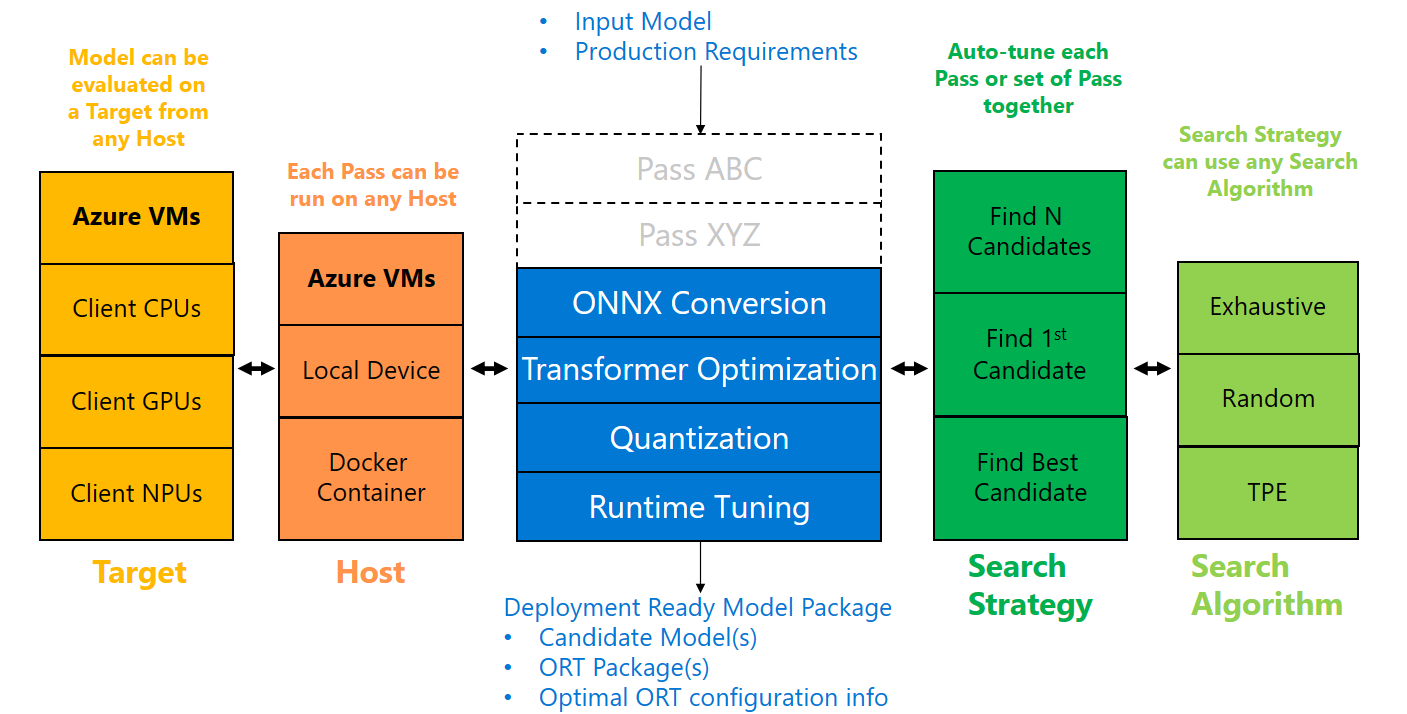Design
In this section, we discuss the core design concepts of Olive. Olive is composed of modular components that are composed to construct a model optimization workflow.
The workflow which is run by the Engine is composed of Passes that are executed in a specific order. Each Pass is responsible for performing a specific optimization on the model. Each Pass might have a set of parameters that can be tuned to achieve the best metrics, say accuracy and latency, that are evaluated by the respective Evaluator. The Engine employs a Search Strategy that uses a Search Algorithm to auto-tune each Pass one by one or set of Passes together.
Each Pass can be run on any host System and its output model can be evaluated on the desired target System.
Olive can be used to find the “best” candidate model, pareto frontier models (for multi-objective search), or the first model that meets some metric goals.
The following diagram illustrates the relationship between the different components:

Pass
Passes are the building blocks of an Olive workflow. A Pass performs a specific model optimization technique such as ONNX conversion or ONNX quantization.
Each pass is configured using a set of required and optional parameters. A Pass config parameter might have a default value and default searchable values. When initializing a pass, the user can chose to set the values of parameters to their default value (no search), default searchable values (search for the best value from the possible options) or a combination of the two (fix some parameters to a certain value, default or user provided, and/or search for other parameters).
System
A system is the environment (OS, hardware spec, device platform, supported EP) that a Pass is run in or a Model is evaluated on. It can thus be the host of a Pass or the target of an evaluation.
The Pass host provides an environment with the required OS platform and packages to execute the optimization technique.
The Evaluator target will ideally have the same specs as the desired deployment environment.
Olive supports five main types of Systems:
LocalSystem: The local machine and environment. The Pass or model evaluation is run in the active python environment on the host machine.
AzureMLSystem: An AzureML workspace compute and environment.
DockerSystem: A docker container running on the host machine.
PythonEnvironmentSystem: A python environment on the host machine.
IsolatedORTSystem: A light-weight python environment on the host machine with ONNX Runtime installed. Only supports evaluation of ONNX models.
Evaluator
An Evaluator is used to evaluate a model on a specific target and return values for some metrics.
To initialize an Evaluator, the user must provide a list of Metrics and the target system.
Olive provides three in-build Metrics, accuracy, latency(ms) and throughput(tps, token per second), along with the options of the user to provide their own custom metric.
Engine
The Engine executes an Olive workflow and is responsible for
Managing and executing the passes
Managing input, output and intermediate models
Evaluating intermediate or final output models as needed
The Engine uses a Search Strategy to auto-tune the Passes one by one or the set of Passes together. The Search Strategy in turn employs a search algorithm to sample the search spaces of the Passes.
The user configures the engine using a configuration dictionary that also selects the search strategy to use. Passes are then created and registered along with their host system and evaluators if any.
The engine also maintains a cache directory to cache pass runs, models and evaluations.
Search Strategy
Search strategy provides an optimization pipeline that finds the best search point from the search space of one or more passes.
It consists of two sub-components – execution_order and search_algorithm.
Execution Order
The execution order defines the order in which the passes are optimized.
Currently, we support two execution orders:
joint: The search spaces of all passes are combined and searched together to find the best search point. Each search point that is evaluated has parameters for the search parameters of all passes.pass-by-pass: The search space of each pass is searched and optimized independently in order.
Search Algorithm
Search algorithm operates over a search space and provides samples/trials (search points) from the search space to execute and evaluate.
The following search algorithms have been implemented:
exhaustive: Exhaustively iterates over the search space.random: Randomly samples points from the search space without replacement.tpe: ample using TPE (Tree-structured Parzen Estimator) algorithm to sample from the search space.